How come that most people are right-handed? This question can not be answered easily. Scientists have discovered that various factors are involved in this matter, e.g. genes and environmental influences.
_
_______Left-handedness
| |
| Females |
9.9 % (1) |
|
| Males |
12.6 % (1) |
|
| Chimps |
33 % (2) |
|
| Other apes |
>50 % (3)
|
|
|
|
Not very long ago scientists have discovered that apes are usually left-handed - see table. At the moment is being claimed that left-handedness is not exclusive trait in mamals since it can be observed in birds, reptiles and walruses and whales as well!
|
Nevertheless, many questions are not answered yet. For example: the evolutionary aspect of 'handedness' is still a mystery. Though researchers have established that left-handedness is related to the asymmetry in the hemispheres of our brains.
In the perspective of this insight + the observations described in the section
Evolutionary handanalysis, it is fascinating to notice that usually the right thumb is a bit longer compared to the left thumb. But my own hands - I am left-handed - show a different picture: my left thumb is about a fifth of an inch longer compared to my right thumb. The research results presented in the sequel of this page indicate that actually in many left-handed people the left thumb is longer compared to the right thumb.
And the results indicate that the hands of the studied left-handers show other unusual asymmetric features as well.
All about asymmetric characteristics in the hands of left-handed people!
|
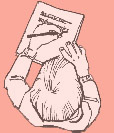
|
LEFT-HANDEDNESS:
the MYTH & the MYSTERY |
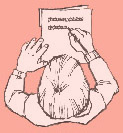
|
|
Above is mentioned that the 'how' and 'why' of left-handedness is still a mystery.
Various theories describe an explanation for the origins of left-handedness, often supported by empirical research evidence. However, the complexity of the phenomenon 'handedness' is illustrated by the fact that far most of these theories are weakened by other research evidence (4). This unstable foundation provides an explanation why many myths have evolved around the phenomenon 'left-handedness' (5).
A popular myth concerns the idea that left-handedness is usually accompanied with a so-called dominant right brain hemisphere personality.
Research has indicated that in left-handed people the right brain has a dominant role related to fine motoric movements, and in general one might say that the right brain is the more 'emotional' and 'holistic' brain. However, the assumption that left-handedness is accompagnied with a dominant right brain hemisphere personality is a myth and belongs to the world of mythology.
Nevertheless, it has been established that in many living organisms the relation between 'handedness' and body asymmetry is not exclusive for the brains (6) - by the way psychologist Marian Annett wrote a complete book on the relation between handedness and the asymmetry of the brain hemispheres. Therefore it is actually not really a surprize that morphological differences between the both hand are related to handedness
(7). The sequel of this page is a presentation of insights which I have derived from my research results.
|
|
LEFTWARD---- thumb---- size-asymmetry:
an indication for LEFT-HANDEDNESS!
The section Evolutionary handanalysis shows that the length of the thumb has appeared to be a major factor the evolution of human kind. We will now discover that thumb length is related to the use of our hand functions as well.
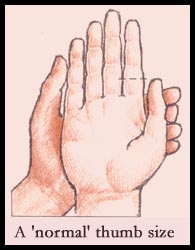 In general one might say that in most people the
thumb of the right hand is a bit longer compared to the thumb of the
left hand. One can observe this by putting both hands on a flat
surface while pushing the thumb against the palm. In this position
one can use the lower phalange of the index finger in order to judge
the thumb length. Usually the tip of the thumb ends near the middle
of the lower phalange of the index finger - see: the dotted
line within the illustration. In this example the thumb size can be
classified as 'normal'.
In general one might say that in most people the
thumb of the right hand is a bit longer compared to the thumb of the
left hand. One can observe this by putting both hands on a flat
surface while pushing the thumb against the palm. In this position
one can use the lower phalange of the index finger in order to judge
the thumb length. Usually the tip of the thumb ends near the middle
of the lower phalange of the index finger - see: the dotted
line within the illustration. In this example the thumb size can be
classified as 'normal'.
By executing this experiment on several
people you will very likely find out that in quite a lot of people
the right thumb size is (a bit) longer compared to the left thumb
size.
In my dissertation study
in psychologie (1997) this aspect of the hand was studied with the above described research method on 103 subjects. The size of the thumb was classified by means of the following scores:
1 = too short
2 = a bit short
3 = normal
4 = a bit long
5 = too long
Since handpreference was
registrated as well, the database of my Master Thesis provides us an excellent
opportunity to study the relation between thumb size-asymmetry and
left-handedness.
In order to make the research results
insightfull, the graphics below visulize the so-called thumb size-asymmetry'-score against 'handedness' for both men and women.
The 'thumb size-asymmetry score' is defined as the score of the right thumb minus the score of the left thumb.
An example:
In case the right thumb can be described as 'a bit long' (score = 4) and the left thumb can be described as: 'normal' (score = 3), then this results in dan a 'thumb size asymmetry score': +1 (= 4 - 3).
A positive
score can be described as rightward
thumb size-asymmetry.
A negative score can be described as leftward
thumb size-asymmetry.
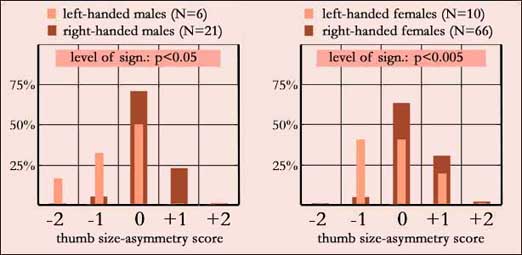
The RESULTS:
The results in the above graphics indicate that
leftward thumb size-asymmetry is rarely observed in right-handed people. This phenomenon is observed in less than 5% of the studied right-handed men and women.
On the contrary: leftward thumb size-asymmetry has been observed frequently in left-handed subjects. For in the studied subjects this phenomenon has been observed in 50% of the left-handed men and 40% of the left-handed women.
CONCLUSION:
In case the left thumb is much longer compared to the right thumb,
this appears to be a strong sign for left-handedness
Final notification: I noticed the relation between 'handedness' and thumb size-asymmetry in the first half of the year 2002. Some observations in the hands of a left-handed person inspired me to focuss on this matter and to study this relations in detail. This implicates that my observations in the hands of the subjects who participated in my desertation study in 1997, are not biased by so-called presumptions.
LEFT-HANDEDNESS &
leftward finger length asymmetry
The above described results on the thumb size lead to the question: how far are likewise relations noticed regarding the other fingers?
|
|
In 1998 I have exectued a follow-up study on my Master Thesis, which includes digital photoscans of the hands
of 99 new subjects. A digital photoscan provides the opportunity to measure the exact absolute finger length.
The results of a data analysis on the absolute length of the fingers is presented in the figure.
The percentages represent the number of cases with a longer finger in the left hand.
[By the way, thumb size is excluded from these measurements for the absolute thumb length can not be measured from a photoscan because of the position of the thumb - which is usually opposed to the fingers]
|
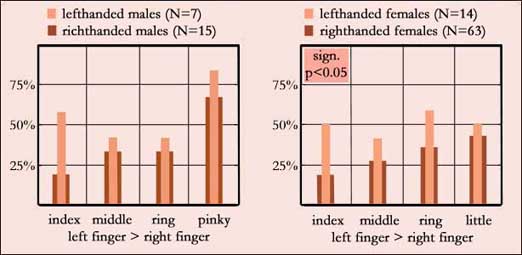
The RESULTS:
The results in the above graphics indicate that in right-handed people the fingers of the right hand are usually longer compared to the fingers of the left hand. Rather remarkable is that this phenomenon is most pronounced on the fingers positioned at a small distance from the thumb.
A different picture is noticed in the hands of left-handers: on most fingers the results indicate that about 50% of the studied subjects have a longer finger in the left hand!
In general one can conclude that the relation between left-handedness and leftward thumb-size asymmetry is also noticed on the other fingers, however the size of this phenomenon clearly depends on the distance between the finger and the thumb.
LEFT-HANDEDNESS
& handpalm asymmetry
Finally I have also examined the possibility of a relation between left-handedness and the length + width seizes of the palm.
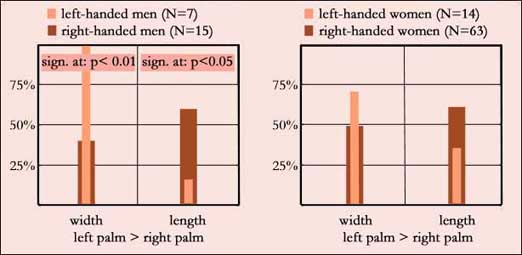
The RESULTS:
The figures in the above graphics indicate that in right-handed people the right palm is often wider than the left palm, however rather remarkable is that in right-handed people the right palm is more often shorter than the left palm!
In the studied left-handers the left palm is usually wider than the right palm, however the left palm is usually shorter than the right palm!
[The described results appear to indicate that on the basis of handfeature combinations a protocol can be designed in order to determine the disposition to be(come) a left-hander]
UPDATES:
- January 2005: a follow-up program is in progress.
- April 2005: I have been able to continue this program via the hands of 10 identical mirror-twins: the above mentioned results are being confirmed!
- January 2011: Learn more about left-handed people!
REFERENCES:
1. Raymond, M.; Pontier, D.; Dufour, A.; and Pape, M. (1996). Frequency-dependent maintenance of left-handedness in humans", Proceedings of the Royal Society of London, B, 263, 1627-1633
2. "Our left-handed cousins"
3. "Handedness in primates"
4. "What causes left-handedness?"
5. "Left-handedness myths"
6. "Biological asymmetry and handedness"
7. "The effect of hand preference on hand anthropometric measurements in healty individuals"
|


 In general one might say that in most people the
thumb of the right hand is a bit longer compared to the thumb of the
left hand. One can observe this by putting both hands on a flat
surface while pushing the thumb against the palm. In this position
one can use the lower phalange of the index finger in order to judge
the thumb length. Usually the tip of the thumb ends near the middle
of the lower phalange of the index finger - see: the dotted
line within the illustration. In this example the thumb size can be
classified as 'normal'.
In general one might say that in most people the
thumb of the right hand is a bit longer compared to the thumb of the
left hand. One can observe this by putting both hands on a flat
surface while pushing the thumb against the palm. In this position
one can use the lower phalange of the index finger in order to judge
the thumb length. Usually the tip of the thumb ends near the middle
of the lower phalange of the index finger - see: the dotted
line within the illustration. In this example the thumb size can be
classified as 'normal'.


![]()